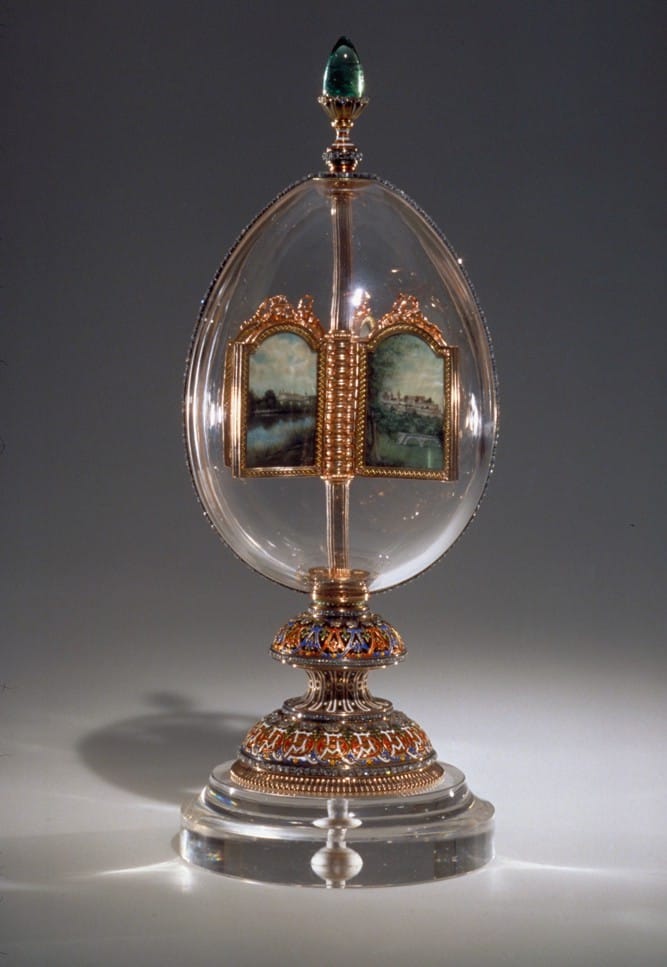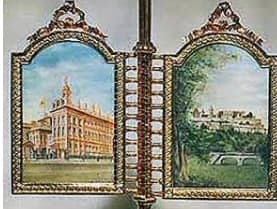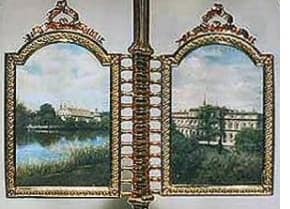Revolving Miniatures Fabergé Egg or Rock Crystal Fabergé Egg
The Revolving Miniatures Egg is an Imperial Fabergé egg, one in a series of fifty-two jeweled eggs made under the supervision of Peter Carl Fabergé for the Russian Imperial family. It was created in 1896 for Empress Alexandra Feodorovna of Russia.
The egg was created by Faberge’s workmaster, Mikhail Evlampievich Perkhin with miniatures by Johannes Zehngraf. It stands about 248 mm in height on its stand, with a diameter of 98 mm. The outer shell is rock crystal banded with emerald-green enameled gold studded with diamonds. On the apex of the egg is a 27-carat Siberian emerald supported by an emerald-green enameled gold mount. This cabochon-style emerald is one of the largest gemstones Fabergé used in any of the Imperial eggs. The egg’s base sits on a plinth of rock crystal. The base consists of a colorfully enameled gold double spheroid which is circled twice with rose-cut diamonds. It has the monograms of the Tsarina, as the Princess Alix of Hesse-Darmstadt before her marriage, and later as Alexandra Fedorovna, Empress of Russia. Each monogram is surmounted with a diamond crown of the respective royal house. These monograms form a continuous pattern around the base of the egg. The surprise is inside the rock crystal egg is a gold support holding twelve miniature paintings. The paintings are of the various palaces and residences that were significant to the Empress. Each location holds a special memory for Nicholas and Alexandra in the early days of their courtship, as they had just been married two years prior, in 1894.
When the large cabochon emerald on the apex is depressed it engages a mechanism that rotates the miniatures inside the egg. A hook moves down and folds the framed pictures back, like the pages of a book, so two paintings can be fully seen at one time. Each miniature is framed in gold with an emerald on the apex. The frames are attached to a central fluted gold shaft which passes vertically through the egg.
The locations include:
•New Palace Darmstadt: The palace in which the princess was born.
•Kranichstein, Hesse, hunting château Kranichstein: A favorite summer residence of the Empress’ youth.
•Balmoral Castle, Scotland: Childhood holiday destination of Alexandra’s grandmother, Queen Victoria.
•Veste Coburg (Coburg Fortress), Coburg: The palace where Nicholas and Alexandra were engaged to be married, during the wedding of Grand Duke Ernst-Ludwig of Hesse and by Rhine to Princess Victoria Melita of Saxe-Coburg and Gotha in 1894.
Wolfsgarten, Hesse: Hunting lodge Alexandra’s family visited as a child.
•Windsor Castle, near London, England: A residence of Queen Victoria where Alexandra visited as a child.
•Cathcart House (and West Park United Reformed Church), Harrogate, UK: Boarding House where Alexandra stayed while taking the baths in Harrogate and where she became godmother to the just born Allen twins.
•Schloss Rosenau, Coburg: A site Nicholas and Alexandra visited the day after their engagement.
•Osborne House, Isle of Wight: Site of Nicholas’ visit to see Alexandra while they were engaged.
•The Winter Palace, St. Petersburg: The site of Nicholas and Alexandra’s wedding.
•Anichkov Palace, St. Petersburg: Residence of Dowager Empress Marie Feodorovna of Russia, where Alexandra spent her first year in Russia.
•The Alexander Palace, Tsarskoe Selo, near St. Petersburg: the Imperial family’s preferred winter residence.
24 March 1896 O.S. Presented to Empress Alexandra Feodorovna of Russia, a gift from husband, Tsar Nicholas II of Russia at a cost 6,750 silver rubles.
10 April 1909 O.S. Housed in Alexandra Feodorovna’s study at the Winter Palace
16-20 September 16-20 1917. One of forty or so eggs sent to the Armoury Palace of the Kremlin in Moscow by the Kerensky Provisional Government for safekeeping
Currently housed at the Virginia Museum of Fine Arts, Richmond.




